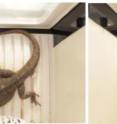Bearded dragons change color on different body parts for social signals and temperature regulation
New research shows that bearded dragons are able to partition colour change to specific body parts, depending on whether they are responding to temperature or communicating with other lizards. The study revealed that colour change in the neck area was only linked to social interactions with other bearded dragons, but by changing their backs to a darker colour in cool weather, the lizards were predicted to save approximately 85 hours of basking time during the energy-intensive breeding season.
Ms Kathleen (Katie) Smith led the research project, as part of her Masters of Philosophy at the University of Melbourne.
Twelve wild-caught bearded dragons (Pogona vitticeps) were observed at different temperatures and during social interactions in the breeding season in northern Victoria, Australia.
While many lizards use colour change for camouflage, communication and regulating body temperature, we wanted to understand how an animal might accommodate all of these different functions at once, Ms Smith said.
"The ideal internal body temperature for a bearded dragon lizard is 35 degrees centigrade. In order to maintain this temperature, a bearded dragon can change its back to a light yellow colour when it is hot to adark brown colour when it is cool." Ms Smith added.
"Interestingly, the chest and beard do not change colour in response to temperature, but change dramatically from cream to jet black during social interactions, accompanied by head-bobs and push-ups.
"Our results suggest that a bearded dragonlizard can balance all of its colour change requirements by only changing colour on the back for regulating temperature (which appears to be beneficial as it is exposed to the sun), and only changing the beard/chest colour for social communication (which is the region displayed to other lizards)."
'The lizards also changed to dark colours very quickly, indicating that this may be an important adaptation for rapidly warming body temperatures."
The team predicted that the dark colour change would allow more of the sun's energy to enter the lizard's body and warm it, so they studied the absorption and reflectivity of the bearded dragon's skin.
The bearded dragons were photographed during exposure to temperatures of 15 or 40 degrees centigrade, and the levels of light reflected from the lizard's skin were recorded to collect the energy-rich wavelengths in the UV-visible and near infrared range (700-2600nm).
The spectrum of light was analysed by a script written by Professor John Endler from Deakin University, and then incorporated into a computer program that modeled lizard behavior at different temperatures.
"By changing to a darker colour in cooler temperatures, the bearded dragons reflected much less light than the paler coloured lizards, at 8% and 23% reflectivity respectively." Prof Endler said.
"The darker lizards would heat up to their active state an average 22 minutes earlier, thereby allowing them to also move away from predators sooner."
"Our modeling predicted that the lizards with a darker colour only on their backs could save approximately 85 hours of basking time needed to reach active body temperatures during the breeding season."
Ms Smith said that the next steps in the research were to look at temperature-dependent colour change in the wild and how these lizards might change colour when faced with conflicting requirements (camouflage, communication, and thermoregulation). .
The work is published in the journal Proceedings of the Royal Society B and was conducted by Ms Kathleen Smith, Dr Devi Stuart-Fox, Associate Professor Michael Kearney and Dr Viviana Cadena (School of Biosceinces, University of Melbourne), Professor John Endler (Deakin University) and Professor Warren Porter (University of Wisconsin).
Source: University of Melbourne
Other sources
- Bearded dragons change color on different body parts for social signals and temperature regulationfrom Science DailyWed, 8 Jun 2016, 16:40:59 UTC
- Bearded dragons change color on different body parts for social signals and temperature regulationfrom PhysorgWed, 8 Jun 2016, 15:21:26 UTC
- Sex-Reversed Bearded Dragons Lay Eggs, Act Like Malesfrom Live ScienceWed, 8 Jun 2016, 12:21:02 UTC
- Photos: Gorgeous Bearded Dragons Show Offfrom Live ScienceWed, 8 Jun 2016, 11:51:03 UTC
